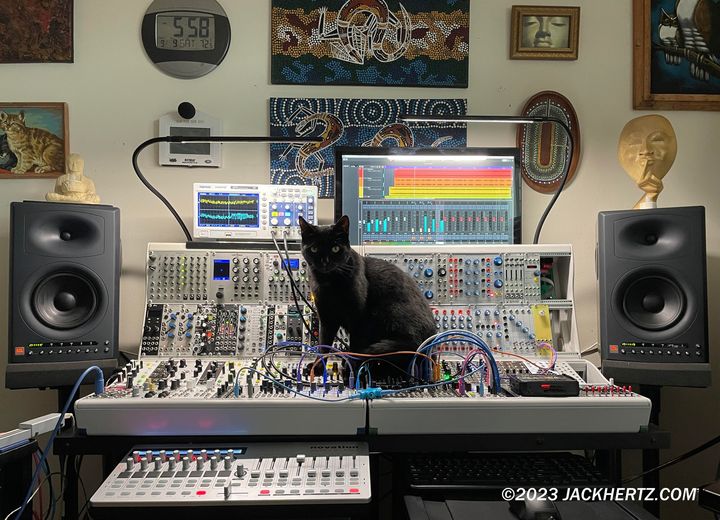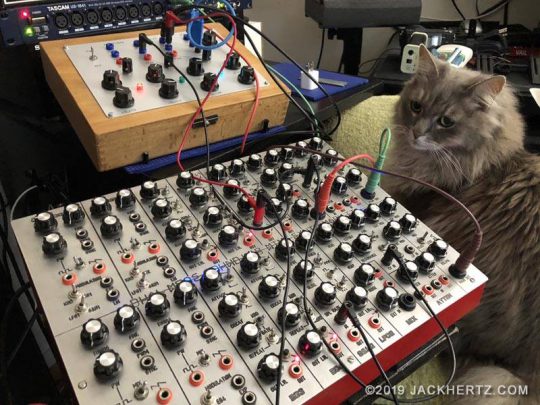
Beautiful black cat KC sits atop a very large and impressive modular system. We also see a Novation controller.
From our friend Jack Hertz, whom we hope gets a chance to share the modular with KC.


Thor proudly shows off the patch on his modular system. From our friend and occasional-collaborator Jack Hertz.
Thor made me a patch for #FathersDay.

Thor returns to CatSynth. He is a synth cat who lives with our friend Jack Hertz.
“Thor plays a mean synth lead…”
Last week we reported on the the first night of NextNow Presents All Tomorrow’s After Parties that featured a performance by Vacuum Tree Head. Today we look at the next night of that festival, which took place on June 4 in Berkeley.

That event marked the debut of one of my new bands, Census Designated Place (or CDP). For this set, I was joined by Mark Pino on drums and Rent Romus on alto sax. The concept for this group is to combine my increased focus on jazz and funk with experimental sounds and ideas. We did two compositions of mine, plus an improvisation based on a graphical score painted by Mark. You can see and hear our full performance in this video.
CDP at Berkeley Arts, June 2016 from CatSynth on Vimeo.
Overall I was quite pleased with the set, and we all had a lot of fun. There is still some work to do tightening up the tunes (particularly White Wine), but that will come with time and practice. We were at our best with the rhythmic and idiomatic improvisation sections in all three pieces, especially the straight-eighth jazz and “disco” sections. And Rent did a tremendous job sitting in with the group, bringing a unique sound and style that I hope to continue in future performances.
All three of us also participated in the Lingua Incognita Session a project conceived by Mika Pontecorvo that also debuted at this event. The large ensemble featured two bassists (Eli Pontecorvo and Robert Kehlmann ), two drummers (Mark Pino and Aaron Levin, four wind players (Rent Romus, Kersti Abrams, Jaroba and Joshua Marshal, trumpet (Tony Passarell), keyboard (myself), and experimental electronics (Jack Hertz).









This was quite a cast of characters to put together in a single group, let alone a purely improvisational group that had not rehearsed together before. And it could have pure cacophony, but everyone did their part to make this work. We started with a concept based on A Love Supreme, with different performers moving in and out of the texture, which moved between sections of rhythmic jamming and more abstract tones. I know I had a lot of fun, as did others, and we hope to do this again sometime.
The day began quite a bit earlier with Shiva X, which featured Tony Passarell on tenor saxophone and Robert Kehlmann – both of whom were part of the Lingua Incognito set – along with Jim Frink on drums.

This group has some conceptual similarities with CDP, combining noisy elements with steady rhythmic drums and bass, but with a more freeform upper layer provided by Passarell’s saxophone. My favorite moments were when things converged on a groove.
Shiva X was followed by Trois Chapeaux. The group featured Jaroba, Kevin Corcoran and Jorge Bachmann (with regular member Tania Chen absent on this occasion).

This was a much more abstract sound, combining both small electronics and acoustic elements along with Bachmann on modular synth. Recognizable sounds and fragments came in and out of focus throughout the set, while clouds of noise and complexity coalesced and then dissipated.
Jack Hertz was next with a solo electronic performance. Sitting alone and unassuming at the from the room, he brought forth a variety of sounds from synthesizers, recordings, and other sources into a continuous force of music and noise. There were some soft but still delightfully crunchy moments in there as well.

The following set shifted from electronic to acoustic, but in such a way that many of the same sonic elements were preserved. There is probably few acoustic duos that sound as “electronic” as T.D. Skatchit, featuring Tom Nunn and David Michalak on sketch boxes.

The sounds of the sketch box are quite unique, and particularly tuned with the musicians who play it the moment. But there is still a tremendous variety.
Then it was time for Reconnaissance Fly, featuring the new lineup that now includes Brett Carson on keyboards along with Polly Moller (flute, guitar, voice), Tim Walters (bass), Rich Lesnick (winds) and Larry-the-O (drums).

The played a variety familiar tunes from the band’s catalog, including a couple from the first album, the recent regular rotation, and a couple of brand new songs. The overall sound of the group has coalesced into something that has strong jazz elements also quite whimsical and esoteric.
After CDP was v’Maa, a “drone band based upon Sami shamanism and spider mythology” (as described on Mark Pino’s blog). The group featured video and music with Mika Pontecorvo, Eli Pontecorvo, Kersti Abrams and Mark Pino. They were joined on this occasion by Lau Nau on voice.

After the intensity of many of the previous sets (including CDP), there was a more subdued quality, a bit more floating and meditative. The swells and ebbs in the overall texture worked will with the changes in the video; and it was a great way to relax musically after performing.
Next up was the “Bill Wolter Project”, featuring Bill Wolter on guitar, Moe! Staiano on percussion, Ivor Holloway on horns, and Ron Gruesbeck on synth.

The entire set, which was shrouded in mystery ahead of the evening, focused on made-up tunings anchored by Bill on fretless guitar. The music unfolded truly as an experiment, as the performers moved in out of various sounds within the confines of the new tuning.
The Bill Wolter Project was followed by Earspray, featuring Ann O’Rourke, Carlos Jennings and Mark Pino, who is definitely the hardest working man in the new music scene.

The set was a full explosion of noise, lights and video, made more stark by the performers’ lab coats. The sounds were a mixture of samples, synthesis and drums.
The final set of the evening was Tri-Cornered Tent Show. The current line-up for band features Philip Everett, Ray Shaeffer, Anthony Flores and Valentina O.

As with previous times I have heard the group, there was a foundation of explosive electronics and drum phases and free improvisation that moved between disparate rhythms and melodic lines. And there is a theatricality to the performance. But this performance with Valentina O was more cabaret style with humor and a certain intimacy. Between vocals, drum hits, and electronic sounds from Everett there were bits of quiet and silence perfectly timed for the theater of of the set.
This was an exhausting day of music, both as a performer and an audience member, but a rewarding one. I’m glad we stayed around for the entire day to hear everyone and the wide variety of sounds and styles. Thanks again to Mika Pontecorvo and Eli Pontecovro for putting on this evening, bring together so many musicians for a good cause.
It’s been a while since I have been able to attend Outsound’s regular weekly music series at the Luggage Store Gallery, but I was finally able to do so a week ago. The show featured two very different sets focused on electronics.
First up was the New False Gods, a “supergroup” of sorts featuring Eli Pontecorvo , Jack Hertz, Doug Lynner, Tom Djll, and R Duck.

I am quite familiar with all the artists and count them all as friends, but this is the first time I heard them together as this unit. Musically, this was an improvised set, but Jack Hertz’s rhythmic percussion helped provide a structural foundation for the other sounds, which varied from sparse and light to thick noisy pads. Doug Lynner provided intricate sounds on his Serge modular, and Tom Djll had an intriguing setup with trumpet driving a modular synth.

Next up was Charles Xavier, aka The Xman performing a solo set with electronics and small sound makers. The central instrument in his setup was a malletKAT, an electronic MIDI mallet percussion instrument.

The Xman was musically quite different from the New False Gods. In addition to presenting a series of composed pieces as opposed to a set-length improvisation, his music was centered on standard tonal pitches, albeit sometimes in more atonal arrangements. There was a gentle and playful quality to many of the pieces.
Overall, it was a good night to come back to the series. Hopefully it won’t be so long before I attend again.
The third night of the Outsound New Music Summit featured three sets that spanned a wide range of electronic music history, from analog modular synthesizers to digital laptops and an eclectic mix of technologies in between.
First up was a “power trio” on Serge Modular synthesizers featuring LX Rudis, Doug Lynner and Dmitri SFC.

[Photo PeterBKaars.com.]
I have heard all three perform of Serge synthesizers before, but never together in this way. The result combined their very different performance styles, with intricate and meticulous musical details from Doug Lynner and driving beats from Dmitri SFC. There were also a variety of drones, noise hits and other sonic elements throughout the performance, which consisted of a single 40-minute improvisation.
Next up Instagon with edition 684 of Lob’s long-running project. This all-electronic mixer set featured Andrew Wayne, Tim White, Thomas Dimuzio, Marc Schneider, Mark Pino and Jack Hertz.

[Photo PeterBKaars.com.]
As with most Instagon mixer sets, each of the performed improvised freely in his instruments, with Lob conducting and sculpting the performance in real time on a mixer. The result is at times chaotic and cacophonic, but appropriately so and mixed with sparser moments where the details of a particular playing were brought out. One of the unifying elements was recorded text that appeared at various times before being obscured beneath the noise.
The final set was a digital laptop trio featuring Thea Farhadian, Aaron Oppenheim and Tim Perkis. This was an ensemble formed specifically for this concert.

[Photo PeterBKaars.com.]
For a while it was rather common to see musicians performing solo or in ensembles exclusively with laptops and digital-processing software. It seems to be less common at the moment with the resurgence of hardware synthesizers, and it is becoming more common to see electronic musicians including analog synthesizers like the classic Serge modulars from the first set. This transition is something I have myself participated in as a performing electronic musician. But the trio on this night reminded me of some of the unique sounds that digital systems can create, with access to samples, jumps, and signal processing that takes advantage of artifacts and computation, such as FM and granular synthesis. There was also more subtlety in the music for this set, with some very quiet moments. Unlike the previous sets, this one was broken up into a few distinct compositions.
Overall, it was interesting to hear the different strains of disciplines within electronic music juxtaposed as they were on this evening. Perhaps an interesting follow up would be to pair a modular synth performer with a digital laptop performer in a future concert.